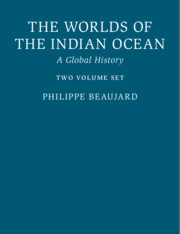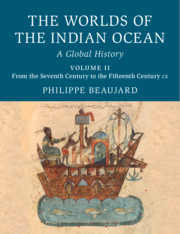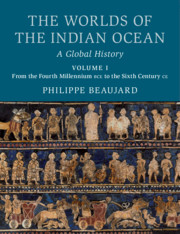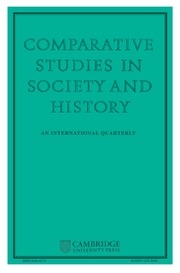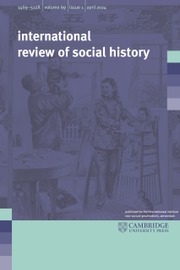The Worlds of the Indian Ocean
Europe's place in history is re-assessed in this first comprehensive history of the ancient world, centering on the Indian Ocean and its role in pre-modern globalization. Philippe Beaujard presents an ambitious and comprehensive global history of the Indian Ocean world, from the earliest state formations to 1500 CE. Supported by a wealth of empirical data, full-color maps, plates, and figures, he shows how Asia and Africa dominated the economic and cultural landscape and the flow of ideas in the pre-modern world. This led to a trans-regional division of labor and an Afro-Eurasian world economy. Beaujard questions the origins of capitalism and hints at how this world-system may evolve in the future. The result is a re-orienting of world history, taking the Indian Ocean, rather than Europe, as the point of departure.
- Thoroughly revised and updated by the author for the first English-language edition, including a wide range of full-color maps and plates
- Offers a new model for the world-system approach by examining the possibility that globalization processes existed in ancient world economies
- Re-assesses Braudel's approach and Wallerstein's theory for regions outside Europe prior to the sixteenth century
Reviews & endorsements
'… an ambitious and thoroughly comprehensive book … It will be a standard reference volume for many generations of anthropologists, archaeologists, economic historians and classicists interested in the deep history of the Indian Ocean.' Chapurukha M. Kusimba, Azania: Archaeological Research in Africa
Product details
No date availableMultiple copy pack
9781108341271
2100 pages
310 × 235 × 205 mm
6.5kg
Table of Contents
- Volume 1. Prologue: the geography of the Indian Ocean and the navigation
- Part I. The Ancient Routes of Trade and Cultural Exchanges and the First States (6th–2nd Millenia BC): Introduction
- 1. The birth of the state
- 2. Early Bronze Age I in Western Asia and in Egypt (ca. 3000–2700 BC)
- 3. Early Bronze Age II (ca. 2700–1950 BC)
- 4. The new spaces of the Middle Bronze Age in Asia and in Egypt (ca. 2000–1750 BC)
- 5. The Late Bronze Age (ca. 1600–1100 BC), an area unified around the Eastern Mediterranean
- 6. East Asia. From villages to states (ca. 5000–1027 BC)
- 7. The emergence of intermediary spaces
- Conclusion: were there world-systems during the Bronze Age?
- Part II. The Birth of the Afro-Eurasian World-System (1st Millennium BC–1st Century AD): Introduction
- 8. The beginnings of the Iron Age
- 9. The roads to the Orient
- 10. India. The birth of a new core
- 11. Southeast Asia, an interface between two Oceans
- 12. China. From Kingdoms to Unification
- 13. Arabia. Maritime cultures and the rise of the caravan trade
- 14. East Africa: the emergence of a pre-Swahili culture on the Azanian Coast
- 15. The Austronesian expansion and the first Malagasy cultures. Volume 2. Part I. The Indian Ocean between Tang China and the Muslim Empire (7th Through 10th Centuries)
- Introduction
- 1. Tang China and the rise of the Silk Roads
- 2. Islam. The conquest of lands and oceans
- 3. India. A core with four centers
- 4. Southeast Asia. The rise of the Sriwijayan Thalassocracy and the Javanese Kingdoms
- 5. East Africa. Dawn of the Swahili culture
- 6. Madagascar (7th Through 11th Centuries). Early Cultural Métissages
- Part II. Globalization during the Song and Mongol Periods (10th–14th centuries), and the downturn of the 14th century
- Introduction
- 7. China. The golden age of the song, the Mongol conquest and the Ming revival
- 8. India: from the Chola Empire to the Delhi sultanate
- 9. Southeast Asia. From the decline of Sriwijaya to the rise of Mojopahit
- 10. Central and Western Asia. From the Seljuk Empire to the Ilkhanids
- 11. Egypt and Yemen. The Jewish and Karimi networks
- 12. East Africa. The rise of the Swahili culture and the expansion of Islam
- 13. Madagascar. The development of trading ports and the interior
- Part III. From the Globalization of the Afro-Eurasian Area to the Dawn of European Expansion (15th and Early 16th Centuries)
- Introduction
- 14. Ming China, from expansion to withdrawal into threatened territory
- 15. India. The flowering of the sultanates and the expansion of Vijayanâgara
- 16. Southeast Asia: era of the merchant sultanates
- 17 Western Asia: revival of the Persian Gulf
- 18. Egypt and Yemen. Advances in state trade and the end of the Karimi
- 19. East Africa and the Comoros
- 20. Madagascar (15th–16th centuries): the rise of trading ports and development of the Highlands
- 21. The Portuguese in the Indian Ocean
- Epilogue.

